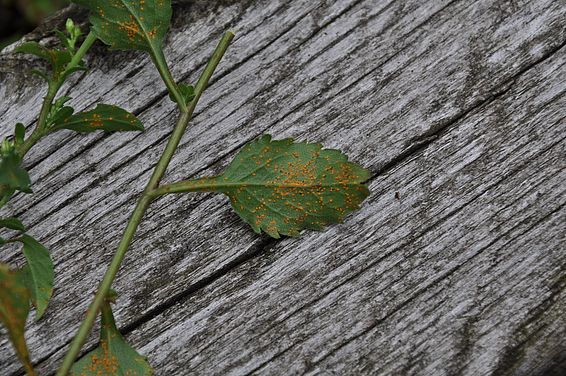
While alien plants (neophytes) and animals (neozoa) are well studied, very little is known about the situation of neomycetes in Switzerland, although certain species can pose a great danger (e.g. ash dieback). In 2016, on behalf of the Federal Office for the Environment (FOEN), WSL prepared a report (in German) on the current state of knowledge on neomycetes in Switzerland.
The report lists a total of 283 known neomycetes for Switzerland, which have been compiled through literature research, evaluation of fungal herbaria, targeted field inspections and genetic investigations. Among them are 13 newly detected neomycetes for Switzerland such as the rust fungus Coleosporium asterum (synonym C. solidaginis) on goldenrod species.
Approximately 51 % of all registered neomycetes belong to the group of tubular fungi (ascomycetes), 36 % to the basidiomycetes and the rest to the egg fungi (oomycetes, 13 %) and the flagellate fungi (chytridiomycetes, < 1 %). Considering all neomycetes, powdery mildews (21 %) represents the largest group, followed by agaric fungi (12%), rust fungi and downy mildews (both 11.7 % each) and pyrenomycetes (6 %). In the way of life of neomycetes, 77 % of all species are parasites (e.g. powdery mildew and rust fungi), 19 % are saprophytes and 4 % are symbionts. Around 75 % of parasites are found only on imported ornamental and useful plants. Most records of neomycetes come from the Swiss plateau and the Ticino of less than 600 m.a.s.l.
The neomycetes were divided into four categories regarding their damage potential for the environment. 26 % of all species were classified as "ephemeral" ("temporarily occurring" species with very few discoveries and no great potential for dispersal), while 63 % were classified as "established" (species that are regularly found but do not exhibit great potential for damage). 5 % of neomycetes have only recently arrived in Switzerland and have the potential to spread rapidly. 6% were classived as "invasive" neomycetes (with high damage potential). We still know very little about many neomycetes and there is a need for research to find out more about their damage potential and possibilities to prevent them from spreading.
